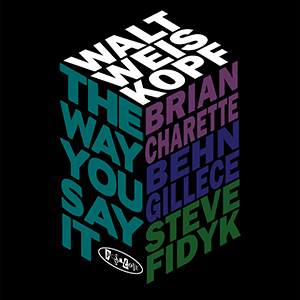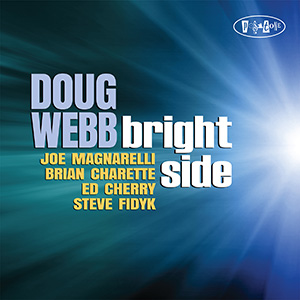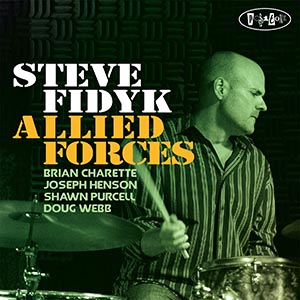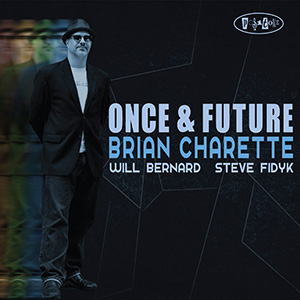 Saxophonist and composer Walt Weiskopf has been a major contributor in the New York (which is to say, world-wide) jazz scene since the early 1980s. After completing studies at the prestigious Eastman School of Music, Weiskopf joined the Buddy Rich Big Band followed by a fourteen-year tenure with the Toshiko Akiyoshi big band. During his time with Akiyoshi and beyond, Weiskopf began recording his own albums playing almost exclusively original music with a variety of groups. Weiskkopf also began his long-running and current association with Steely Dan.
Saxophonist and composer Walt Weiskopf has been a major contributor in the New York (which is to say, world-wide) jazz scene since the early 1980s. After completing studies at the prestigious Eastman School of Music, Weiskopf joined the Buddy Rich Big Band followed by a fourteen-year tenure with the Toshiko Akiyoshi big band. During his time with Akiyoshi and beyond, Weiskopf began recording his own albums playing almost exclusively original music with a variety of groups. Weiskkopf also began his long-running and current association with Steely Dan.
In addition, Weiskopf has become one of the most respected authors in jazz pedagogy starting with his first two books, Coltrane: A Players Guide to His Harmony and The Augmented Scale in Jazz (both co-authored with Ramon Ricker). Other books that followed include Intervalic Improvisation (1994), Around the Horn (2001), Beyond the Horn (co-authored with Ed Rosenberg)(2010) and Understanding the Diminished Scale (2012). Weiskopf has been on the faculty of the Eastman School of Music, Temple University and is currently Coordinator of Jazz Studies at New Jersey City University.
The Way marks Weiskopfs third CD as leader for Posi¬tone, besides at least another dozen for other labels, and represents a change in format, in that Weiskopf uses a modified organ trio as his vehicle of choice. The music, as is his custom, is almost all original, with the exception of three tunes.
To say that Weiskpopf is a master saxophonist is to overstate the obvious. Weiskopf has a clear, clean, centered sound, lickitey-split technique and personality to spare. That covers the “How To Play” side. On the “What to play” side, Weiskopfs melodic, harmonic and rhythmic acumen are massive. All of these attributes are eminently clear in the opening track, a medium-up-tempo blues, Coffee and Scones.
The quirky melody is played by unison tenor and vibes with Weiskopf taking the first solo. As mentioned before, Weiskopf has lots of personality in his playing, beginning with the fact that he plays with no vibrato at all and ends long pitches by just stopping the air, no taper at all. Both of these conditions contribute to his unique voice, but there’s more. Yet another factor are the notes and harmonies that Weiskopf uses. Each chorus that he plays finds him going down a different harmonic path, allowing him to keep the listener interested and on the edge of their seat all at once. Good solos by Gillece and Charette as well.
Inntoene, a barnburner taken at warp speed, is an example of good straight-a-head blowing. Tenor and vibes play the intricate melody once again, with Weiskopf taking the first solo, barreling down the highway, dropping one cleanly executed line after another like some many bombs over his shoulder.
The first of the tunes not written by Weiskopf is the now obscure Candy, by Alex Kramer (lyrics by Mack David & Joan Whitney). Performed as a ballad, for me, this is the money tune of the recording. Weiskopf plays the melody and goes right into his solo chorus paying homage to John Coltrane, with a touch of Jerry Bergonzi. His reading of the melody is just beautiful, and his solo is a study in “this is what a jazz player should be able to do with a tune,” playing it from every angle while still keeping all the music intact.
Segment, by Charlie Parker is another up-tempo gem, with Weiskopf and company just gliding through the changes and the changes of key with ease. Again, Weiskopf displays a complete understanding of harmony and the post-bebop language.Never at a loss for an idea, his lines just flow from one to the other. After a brief two-chorus romp from Weiskopf, Gillece plays his own well executed solo. Tenor and vibes trade eights, then fours for a chorus each before a shout chorus and the final reading of the melody.
The title tune, a prety ballad by the leader closes the CD. The melody is shared by tenor and vibes followed by short solos by Charette and Weiskopf. The mellow feel of the tune lets you down easy after the action packed recording.
Walt Weiskopf is a power with which to be reckoned; if you are not familiar with his playing, this recording is a great place to start to get to know him.
Billy Kerr – Saxophone Today
 From the very first, sweet strains of tenor saxophone that leap from my CD player, I know it’s Doug Webb. I’ve been listening to his style and enjoying the excitement he creates on stage for three decades. Webb has been featured on over 150 jazz recordings and has added his blues soaked style to tracks used in hundreds of television programs and movies. He’s an on-demand, Southern California, saxophone session man for television and film. This, his seventh album release, is funk-based with Manarelli on trumpet blending well with Webb’s saxophone licks. Webb has penned seven out of the twelve songs on this CD. His composition skills showcase smooth technique and a love of melody. The addition of Charette on organ spices things up and thickens the stew when Webb puts the pots on to boil. This is particularly obvious on cut #3, “The Drive”, where everyone of the musicians seem powered up and propel their improvisational skills at a fast clip. I found Webb’s composition, “Melody for Margie” to be beautiful, promoting a visceral emotion. Another of his compositions I enjoyed immensely is “One For Hank” where Cherry on guitar gers to stretch out, as well as Charette on organ. All in all, this CD swings and Webb is flying above the solid rhythm section, as daring as a man on a trapeze. His music is exciting.
From the very first, sweet strains of tenor saxophone that leap from my CD player, I know it’s Doug Webb. I’ve been listening to his style and enjoying the excitement he creates on stage for three decades. Webb has been featured on over 150 jazz recordings and has added his blues soaked style to tracks used in hundreds of television programs and movies. He’s an on-demand, Southern California, saxophone session man for television and film. This, his seventh album release, is funk-based with Manarelli on trumpet blending well with Webb’s saxophone licks. Webb has penned seven out of the twelve songs on this CD. His composition skills showcase smooth technique and a love of melody. The addition of Charette on organ spices things up and thickens the stew when Webb puts the pots on to boil. This is particularly obvious on cut #3, “The Drive”, where everyone of the musicians seem powered up and propel their improvisational skills at a fast clip. I found Webb’s composition, “Melody for Margie” to be beautiful, promoting a visceral emotion. Another of his compositions I enjoyed immensely is “One For Hank” where Cherry on guitar gers to stretch out, as well as Charette on organ. All in all, this CD swings and Webb is flying above the solid rhythm section, as daring as a man on a trapeze. His music is exciting. Straight ahead swinging jazz powered by a crew of leaders in their own rights, drummer Fidyk makes no statements here other than he can keep things on track from the back of the stage and that good are meant to be shared by all. Not the kind of feel good jazz you’d associate with water front bars on summer nights but you have to call it that for lack of a better name, this is smoking stuff that works throughout and is the kind of friendly hard core jazz that brings new listeners into the tent despite themselves. On the money throughout and totally hot.
Straight ahead swinging jazz powered by a crew of leaders in their own rights, drummer Fidyk makes no statements here other than he can keep things on track from the back of the stage and that good are meant to be shared by all. Not the kind of feel good jazz you’d associate with water front bars on summer nights but you have to call it that for lack of a better name, this is smoking stuff that works throughout and is the kind of friendly hard core jazz that brings new listeners into the tent despite themselves. On the money throughout and totally hot. While unboxing guitarist Will Bernard’s delightful
While unboxing guitarist Will Bernard’s delightful  Walt Weiskopf wrote the book on jazz harmonics and improvisation…actually
Walt Weiskopf wrote the book on jazz harmonics and improvisation…actually